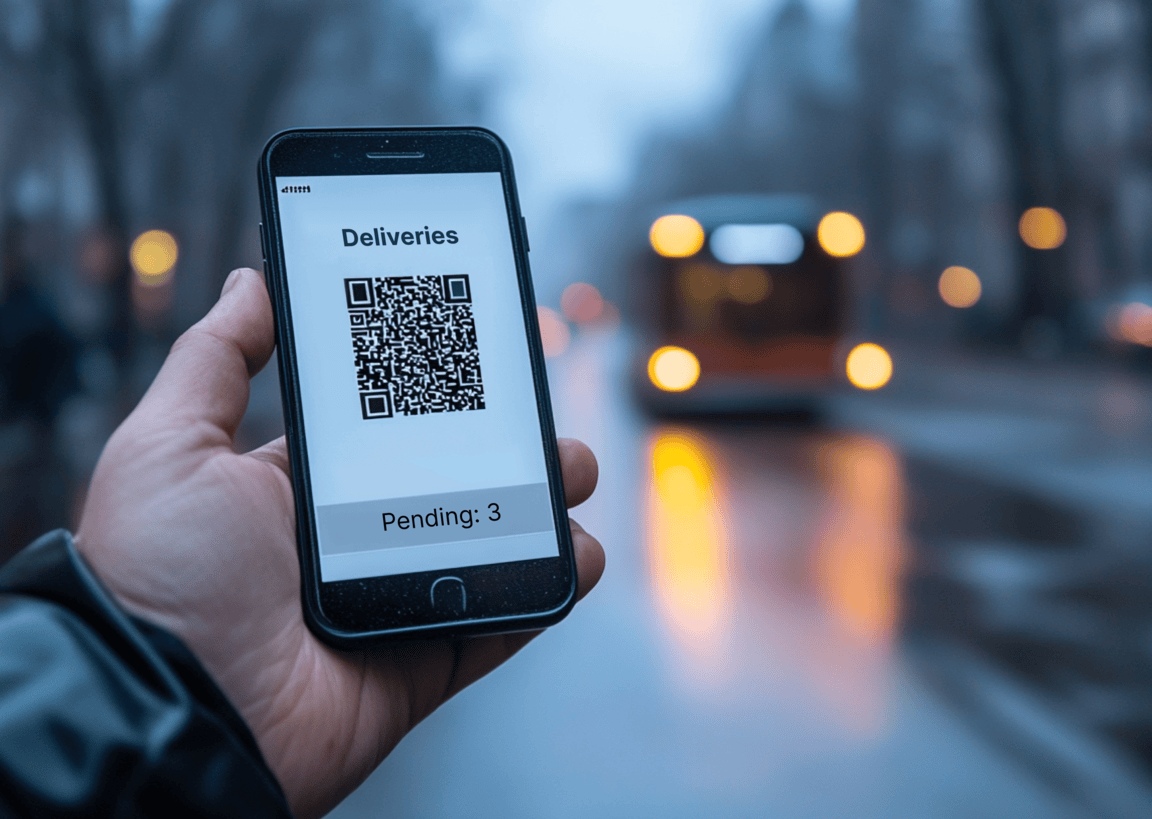The Mailroom's Role in Preventing Internal Delays During BFCM Peak Season

The holiday peak season (Black Friday, Cyber Week, and the crucial weeks leading up to Christmas) has evolved into the biggest stress test for the entire retail supply chain. While consumers excitedly track their purchases from warehouses, the absolute pressure often culminates at the last yard of delivery, which is your residential building's mailroom. Therefore, mailroom managers should recognize this annual surge as a reality that demands a quick but well-thought-out response.
The scale of peak retail demand is enormous. Projections indicate that US holiday spending alone is expected to rise by 7% year-on-year, translating to an average of $1,638 per shopper. This surge in consumer purchasing has a direct impact on mailroom operations. Across Europe, parcel volumes grew by an astounding +93.7% during the BFCM period in 2024 compared to preceding weeks.
Amidst this flood of packages, one problem consistently frustrates recipients more than any other: delays. External carrier delays, which surged by 70% during Black Friday and Cyber Monday (BFCM) week alone, are already a substantial source of customer dissatisfaction. The mailroom's critical role, therefore, is not to compound these existing frustrations but to act as a smooth final link, ensuring that internal processes do not add unnecessary hours or days to a package's journey.
The Last Yard Delay: When the Mailroom Becomes the Bottleneck

Mailroom managers understand that they are not responsible for a carrier's late delivery. However, the period between a package's arrival at the building and its final retrieval by the resident falls entirely within the mailroom's purview. This is precisely where hours, and often days, are inadvertently added to a recipient's total waiting time, transforming external delays into internal failures.
Several key issues contribute to this internal delay paradox:
- Manual Logging: The traditional, slow, and error-prone process of manually entering package details, recipient names, and unit numbers can add significant hours to a package's journey. During peak volumes, this bottleneck can quickly overwhelm staff and create insurmountable backlogs.
- Misplaced Parcels: Without a robust system, a mailroom can become a "black hole" where packages are physically present but unlocatable. Poor organization means staff waste valuable time searching for items, leading to further delays and recipient frustration.
- Notification Lag: One of the most common and frustrating internal delays occurs when a package sits in the mailroom for an extended period simply because the recipient wasn't notified immediately upon its arrival. Every hour a package sits uncollected due to notification lag is an hour added to the resident's wait.
Minimizing Delay Through Radical Transparency and Communication

While external shipping delays are often beyond the mailroom's control, how these delays are managed and communicated upon arrival is entirely within its power. Consumers are remarkably forgiving of delays if they are kept informed promptly and accurately. Transparency, in this context, is the most potent antidote to recipient anxiety and the key to improving the overall experience.
Recipients demand prompt communication. They view confirmation and shipping updates as "essential" (93%) during the holidays, with a striking 75.8% expecting order confirmations within five minutes of purchase. This expectation for speed and certainty doesn't end when a retailer ships. It transfers to the mailroom upon a package's arrival.
This leads to two critical communication protocols:
- Instant, Multichannel Notification: The moment a parcel is logged internally, the recipient must be notified immediately. This means leveraging communication channels that residents actively monitor, ensuring the internal clock on collection begins without delay. While email remains a primary choice, SMS/Text messaging follows closely at 40.9% for transactional communications, and 52.1% of consumers now prefer multichannel updates (e.g., combining email with SMS).
- Proactive, Frictionless Information: Beyond just informing residents that a parcel has arrived, communication should include where it is (e.g., locker, reception desk) and how to collect it (e.g., a QR code, a unique pickup number). This foresight removes friction from the final collection step, streamlining the process for both staff and residents.
Smart Technology Cuts Hours, Not Corners

For residential mailrooms operating with foundational equipment, technology is the ideal complement to physical tools. It provides the only scalable defense against the peak season surge, allowing mailrooms to cut hours from processing, not corners on service.
Here's how technology delivers an advantage:
- The Power of Automation (Eliminating Manual Drag):
- OCR Scanning: Modern mobile mailroom management systems utilize Optical Character Recognition (OCR) technology. Staff simply point a smartphone camera at a label, and the system instantly logs all package details in seconds. This eliminates manual data entry errors and hours of processing time, effectively removing the first significant internal delay point.
- Digital Chain of Custody: Implementing real-time mailroom management software creates an irrefutable audit trail from the moment a package arrives until its final pickup. This includes digital signatures or photo proof of collection, preventing "lost" or misplaced packages, which is a delay that is 100% attributable to the mailroom's process.
- Addressing Digital Volume with Mobile-First Solutions:
- The shift to online shopping is absolute, with a record-breaking 79% of Cyber Week ecommerce traffic coming from mobile devices. Mailroom tracking and notification tools must reflect this reality, offering intuitive, mobile-first interfaces that cater to both staff and residents.
- Data for Future Guardrails: The analytics generated by a parcel management system provide invaluable data. This includes average pickup times, peak arrival hours, and the duration of uncollected packages. This intelligence informs future staffing, space management, and communication strategies, establishing robust guardrails against internal delays in subsequent peak seasons.
Unconventional Tactics That Might Just Work
When traditional mailroom operations are overwhelmed by volume, effective managers turn to unconventional, yet highly practical, tactics. These strategies leverage existing space and technology to maintain fluidity.

- Vertical Staging & Location Tagging: When standard floor space is exhausted, creative use of vertical space becomes critical. Mailrooms can utilize heavy-duty shelving, multi-tier industrial carts, or even temporary stacking crates. The key is that the parcel management system must allow staff to instantly tag a package's temporary location (e.g., "Crate A - Top Shelf"). This prevents packages from being physically present but functionally "lost," eliminating "search delays."
- Controlling the Chaos: The volume of BFCM is often compounded by unseen factors. For instance, "bad traffic," such as bots, accounted for up to 29% of Cyber Five traffic. While not directly mailroom-related, this highlights the often unpredictable and overwhelming nature of peak demand, which results in a flood of actual purchases that must ultimately be processed. Technology and flexible staging help absorb this unpredictability.
- Batch Processing: For high-volume courier drops where individual logging is impossible due to immediate pressure, staff can implement a batch processing protocol. This involves quickly scanning all items to confirm their arrival on-site and instantly notifying recipients that their items have arrived at the property. While final individual sorting may follow, this prioritizes communication and manages expectations, preventing internal notification delays.
Continuously Improving Against an Annual Surge

BFCM and peak season surge are annual certainties. Therefore, a mailroom's strategy against internal delays must be permanent, robust, and continually refined.
The success metric for a mailroom during BFCM is to achieve near-zero internal processing time. If an item has already been delayed by the external carrier, the mailroom's process should not add more than an hour to its overall journey within the building.
A poor post-purchase experience, particularly one caused by internal mailroom delays, risks not just a single package collection but can damage long-term trust and brand loyalty from residents. The mailroom is the last, critical touchpoint in the entire delivery chain. It shapes the final perception of reliability and service.
The choice for mailroom managers and property leadership is to persist with manual, delay-prone processes or embrace an automated, transparent system. Technology provides the only reliable defense against the chaos of peak volume, empowering mailrooms to maintain their reputation as an indispensable and efficient amenity.
Ready to transform your mailroom into a resilient, delay-proof operation this peak season? Explore how Parcel Tracker can streamline your processes and elevate resident satisfaction.






